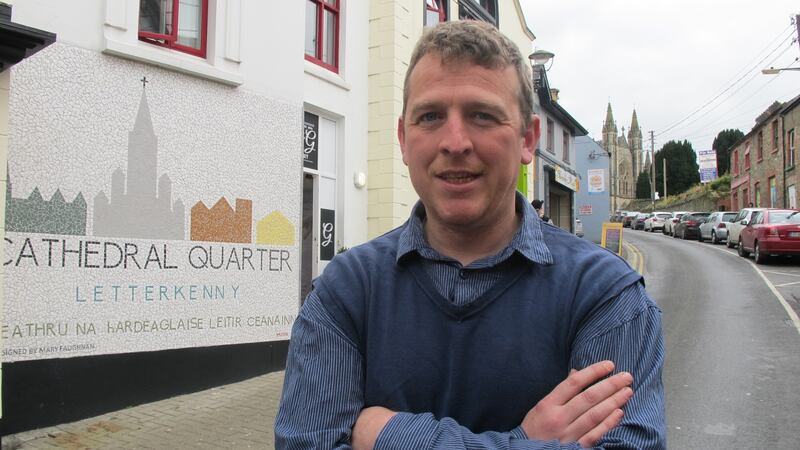The northwest region took a major hit after the recession began almost a decade ago. Letterkenny, in Co Donegal, was one of many towns that saw businesses closing, residents moving away and far fewer tourists visiting.
Now, however, a resurgence that has revitalised a community and its way of life is taking place in the town.
For more than three years, Church Lane had derelict buildings, paint-chipped walls, footpaths overgrown with weeds and just one shop – a small independent bookshop owned by David Faughnan – left open.

![John Russell with his wife, Liz: “[The area] had gone down badly, but now it has changed for the better”](https://www.irishtimes.com/resizer/v2/MNIZX6MDEBL7GSIRNFY7F6HPOA.jpg?auth=118c279bd6ae4465c1517792f2f7a311ee717dbbc8b065ba92a5c6261b631741&width=800&height=450)
“It all went belly-up, and in no time at all, almost overnight, we were the only business left on this street. It was terrible. We were holding on by the skin of our teeth,” Faughnan says. “Thanks be to God, we survived, but only because the community was determined to keep this street alive.”
A plan to revitalise the area started with Donnan Harvey, an unemployed history teacher who watched from the window of his home as the street he grew up on was abandoned. Just 18 months later, much has changed.
“We have been accused of having no soul; now we are trying to bring the soul back to our street,” says Harvey.
He enlisted the help of Shane Toolan, who helped set up Ballyshannon and District Museum, and together the two men sought the support of the community – which was given, without exception.
“A lot of projects start with the idea that you have to raise money. You don’t need money to start something; you just need an idea. By having no plan and no budget and taking baby steps one at a time, we knew we would convince people to come with us,” says Toolan.
The men built up a team of willing volunteers to restore shopfronts and clean the street and they held fundraising events for a number of projects, including a literary festival. They tasked the architectural technology department at Letterkenny Institute of Technology with redesigning the whole street, a plan that has been presented to Donegal County Council, which will now look at developing the idea within its town plan.
“The project now stands at a crossroads. In order to take the right path, the financial and administrative backing of local and national agencies is paramount,” Toolan says. “We want this area to become a vibrant, economically viable, tourist-generating benefit to the whole community, so the soul returns to the centre of the town.”
Important strand
Inclusivity is an important strand of the project.
John Russell, from Manorcunningham, has been attending the gospel hall on Church Lane with his wife, Liz, three times a week for more than 30 years. He has seen a change in the street that has brought businesses and people of differing faiths and traditions closer.
“It had gone down badly, but now it has changed for the better. We used to come for the meetings and then leave; now we feel more part of the community,” he says, as he and others prepare to hold a Christmas-carol event between the four churches in the area.
The street is now referred to as Cathedral Quarter, and in the past 18 months it has seen five independently owned businesses open their doors.
Tara Casey didn’t know much about business before she opened Blooming Mad, a florist’s, in July.
“I hadn’t a notion, but everyone on the street has helped me,” she says. “There’s a wee family feel here. It used to be dead, there was no life here at all. Now you can’t even get parked.”
Sharon Callaghan, who opened Tipsy Nail Bar, says there is “a buzz” on Church Lane now. “It’s changed so much. It now feels like a big thing to be on this street.”
Paul Good, who runs the vegan cafe Wholegreen with his wife, Anna, opened the second business on the street as things began to pick up.
“The fact that the street was empty apart from the bookshop was one of the reasons why we wanted to come here,” he says. “It was an unknown, a big risk, but it is working. The plan by Donnan and the others isn’t just for one or two years, but five, 10 years . . . They are actually trying to create something that will stand the test of time.”









